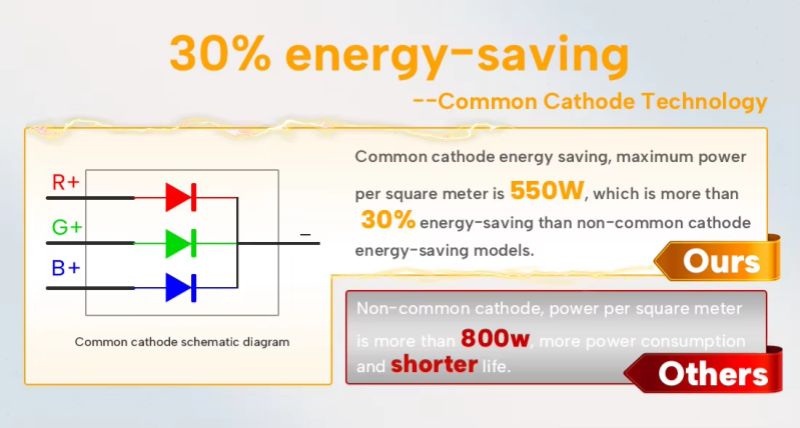In the LED display industry, while traditional common-anode technology is mature and highly stable. The emergence of common-cathode technology has brought significant performance improvements to LED displays. Through precise power supply, LED displays not only save energy but also improve color consistency. And display effects, while extending the lifespan of the LED screen. Moreover, this power supply method fundamentally improves the energy consumption structure of LED displays. So, what are the specific advantages of common cathode LED display screens?
I. Common Cathode LED Display Core Principles
In a common-cathode LED display, the cathodes (negative electrode) of each LED are connected together, while the anodes (positive electrode) are brought out separately. By separately supplying power to the R, G, and B terminals of the LED, the common cathode design precisely allocates the required current and voltage to each.
Because the optimal operating voltage and current required for R, G, B (red, green, and blue) LED chips are different. Precise power supply based on the specific optimal operating voltage and current required by the three primary color LED chips ensures that the current first passes through the LED chip and then to the negative terminal of the integrated circuit (IC), reducing the forward voltage drop and decreasing the on-resistance. This not only improves the energy efficiency of LEDs but also comprehensively reduces the overall energy consumption of the LED screen

II. Advantages of Common Cathode LED Display
For outdoor fixed LED displays, Ningshine’s HO and HD series offer both common cathode and common anode options to meet the budget and performance requirements of different scenarios. For projects prioritizing ultimate energy efficiency and long-term stability, choosing common cathode technology offers the following significant advantages:


1.Precise power supply and high energy efficiency
The most significant feature of common cathode technology is that current flows directly to the cathode of the LED chip. Through precise power supply and efficient energy utilization, It significantly lowers energy consumption. At the same brightness, it avoids the energy waste caused by voltage redundancy in common anode power supplies. Resulting in energy savings of over 30% compared to non-common cathode models.
2. Excellent heat dissipation performance
Because of the reduced energy consumption, less electrical energy is converted into useless heat. Therefore, the heat generated by the common cathode LED display video wall during operation is correspondingly reduced, thereby lowering the screen temperature and significantly extending the LED screen’s lifespan. Furthermore, the superior heat dissipation improves operational stability in high-temperature environments such as outdoor settings during summer.
3. Improve display effect
Because independent powering of the R, G, and B channels allows each to operate at its optimal voltage. This not only ensures color consistency but also improves image contrast. And color saturation, resulting in a more delicate and realistic display. The display effect is particularly outstanding in scenarios requiring extremely high color fidelity, such as advertising, video playback, and stage performances.
4. High reliability and stability
Due to the aforementioned advantages, energy saving and heat dissipation together improve the reliability of LED displays. Common cathode power supply provides a more stable drive current for the RGB three-color LEDs, ensuring that all components of the display are in a “comfortable” operating state. Therefore, this significantly improves the long-term reliability and stability of the screen.
III. Common Cathode LED Display Conclusion
In summary, common cathode LED display power supply technology delivers superior display effects thanks to its precise power supply and energy efficiency. Compared to common-anode LED displays, common-cathode technology offers greater precision in power supply method and voltage distribution, effectively reducing heat generation and power loss. Therefore, common cathode led display technology successfully addresses the energy efficiency and heat dissipation limitations of traditional common-anode power supplies.
